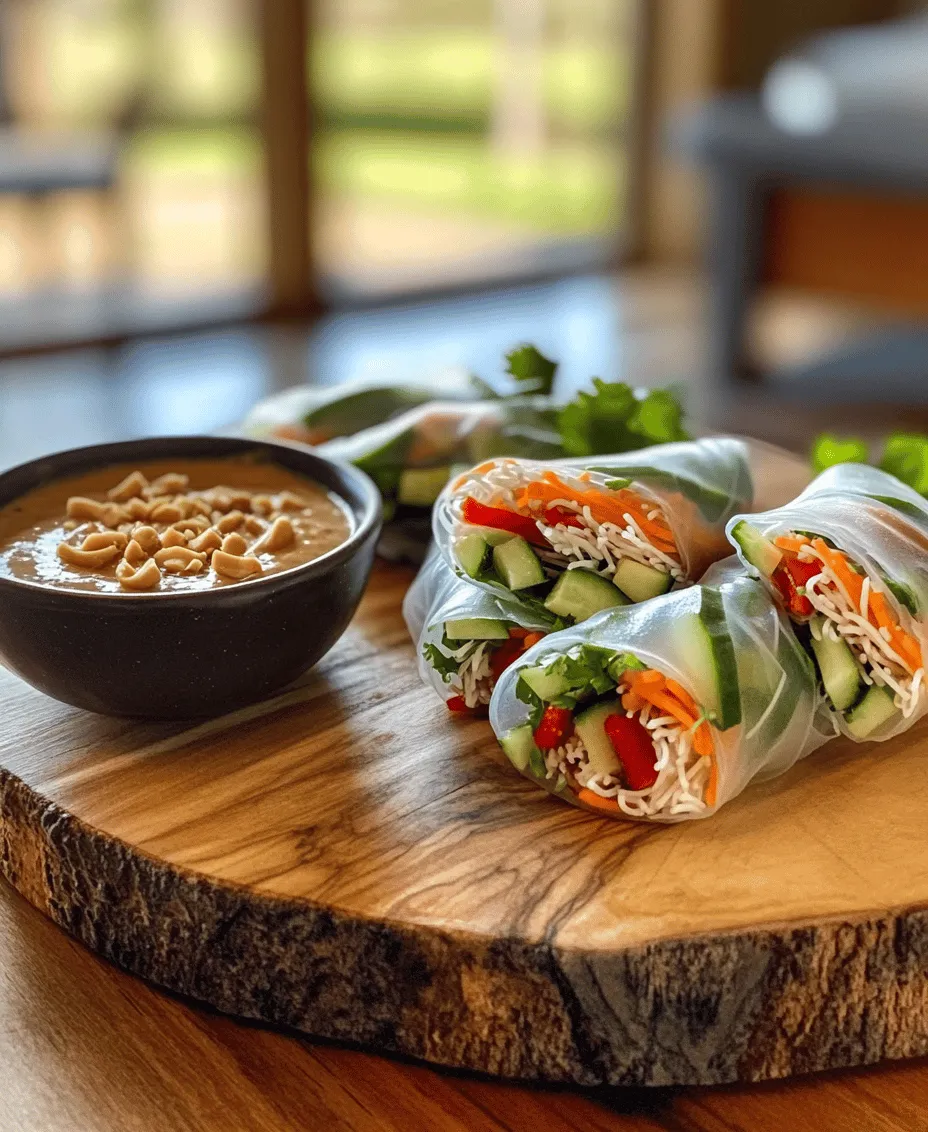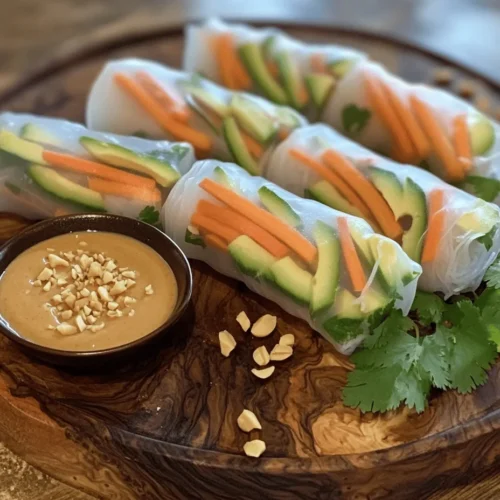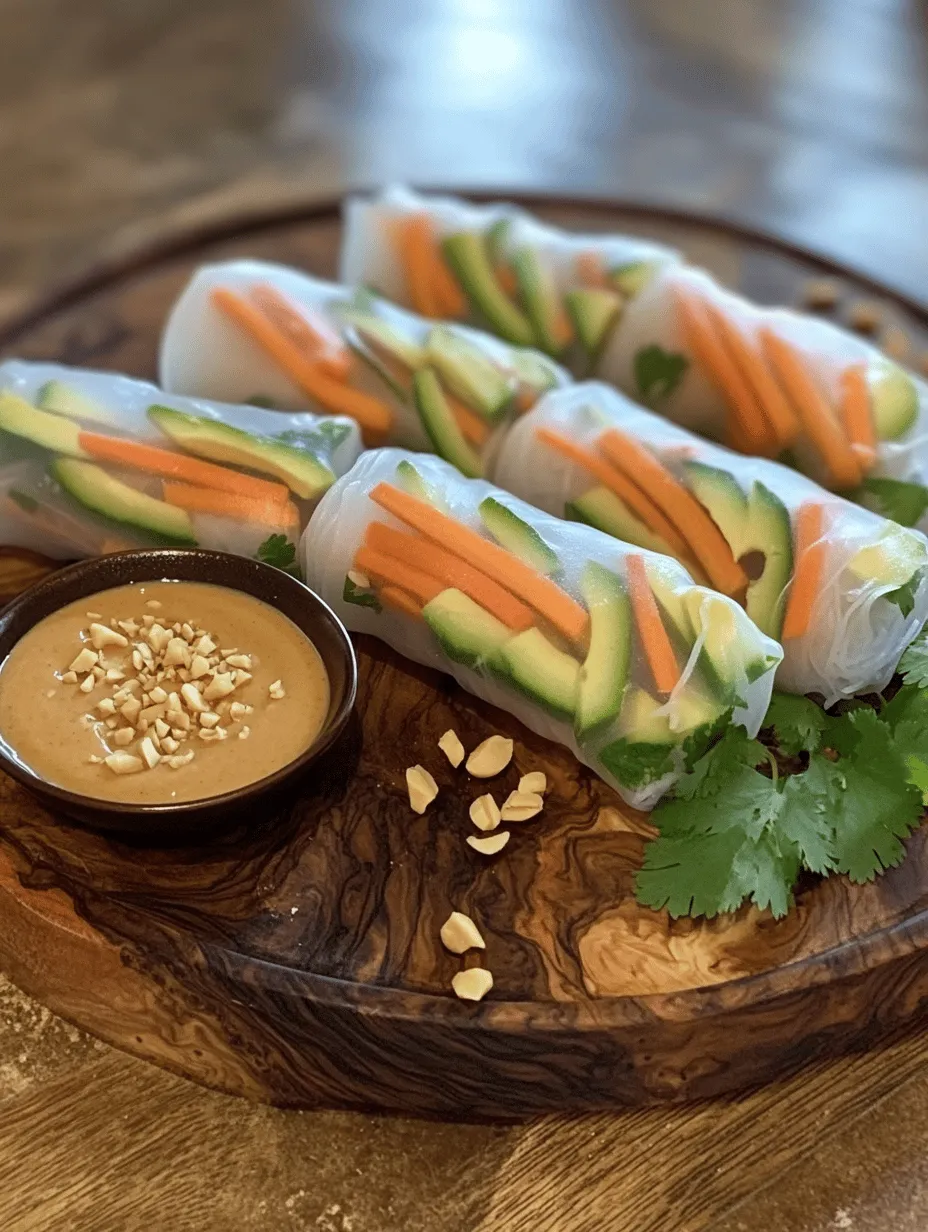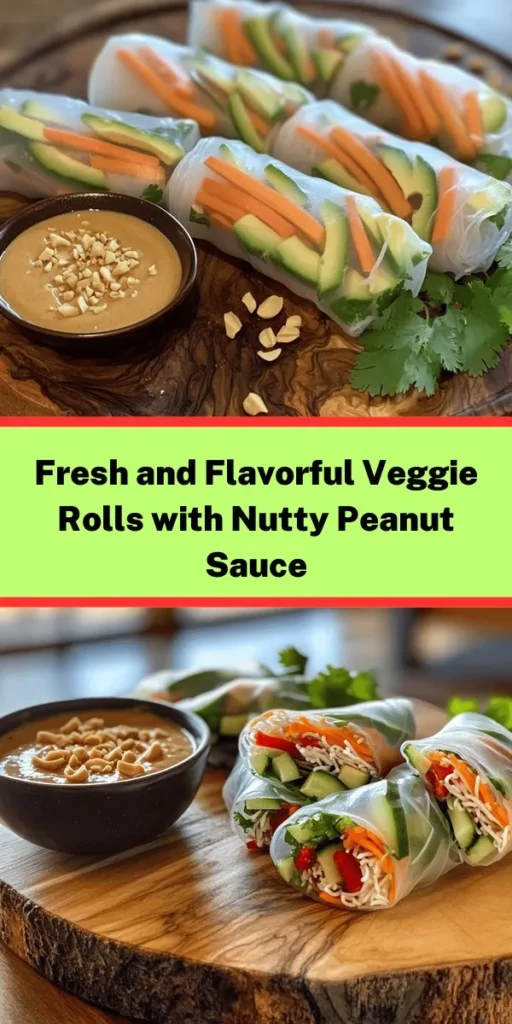Introduction
Fresh veggie rolls are a delightful culinary creation that brings together a colorful array of vegetables, herbs, and proteins, all wrapped in delicate rice paper. These rolls, often associated with Asian cuisine, have gained immense popularity for their fresh taste, versatility, and health benefits. With a growing emphasis on healthy eating, incorporating more vegetables into our meals has never been more important. Not only do they provide essential nutrients, but they also add vibrant colors and textures to our plates.
The Hearty Veggie Rolls with Peanut Sauce stand out as a perfect example of this trend. They are not just a feast for the eyes; they are also packed with flavor and nutrition. Suitable for various dietary preferences, these rolls cater to vegans and those seeking gluten-free options, making them an excellent choice for gatherings or meal prep. Whether you’re looking for a light lunch, a quick snack, or an elegant appetizer for your next dinner party, these veggie rolls will impress.
Understanding the Ingredients
To create these Hearty Veggie Rolls with Peanut Sauce, it’s essential to understand the core ingredients that contribute to their flavor and nutritional profile.
Core Ingredients in the Veggie Rolls
1. Rice Paper Wrappers: These thin, translucent wrappers are made from rice flour and water, commonly used in Vietnamese cuisine for spring rolls. They are gluten-free and serve as the perfect vessel to hold an assortment of fillings. When hydrated, they become pliable and can be filled with your choice of ingredients, making them a versatile option.
2. Quinoa: As a base ingredient, quinoa offers a nutty flavor and a hearty texture. It is a complete protein, meaning it provides all nine essential amino acids, making it an excellent choice for plant-based diets. Additionally, quinoa is rich in fiber, magnesium, and various vitamins, enhancing the nutritional value of the veggie rolls.
3. Fresh Vegetables: The true stars of these rolls are the fresh vegetables. A combination of colorful veggies such as bell peppers, cucumbers, carrots, and leafy greens not only adds crunch and flavor but also boosts the fiber, vitamins, and minerals in your diet. Each vegetable brings its unique taste and texture, making every bite a delightful experience.
4. Peanut Sauce Ingredients: The peanut sauce is what elevates these veggie rolls to the next level. Made with creamy peanut butter, lime juice, honey (or agave for a vegan option), soy sauce, and garlic, this sauce brings a rich, tangy flavor that complements the freshness of the rolls. The versatility of peanut butter as a protein source makes it a popular choice among those looking to enhance their meals with plant-based proteins.
5. Balancing Flavors: Lime juice and honey play crucial roles in the peanut sauce. Lime juice adds acidity, cutting through the richness of the peanut butter, while honey provides a touch of sweetness to balance the flavors. This combination creates a sauce that is both savory and slightly sweet, enticing everyone to dip their rolls generously.
Preparation Steps Explained
Now that we have a better understanding of the ingredients, let’s dive into the preparation steps involved in making these Hearty Veggie Rolls with Peanut Sauce.
Preparing the Vegetables
Start by selecting your favorite fresh vegetables. The beauty of veggie rolls lies in their versatility; you can customize them to your preference. Here are some common vegetables and how to prepare them:
1. Bell Peppers: Choose a variety of colors—red, yellow, and green—for a vibrant presentation. Wash them thoroughly, remove the seeds, and slice them into thin strips.
2. Cucumbers: Peel if desired, then slice them in half lengthwise and remove the seeds. Cut into thin half-moon shapes or strips for easy rolling.
3. Carrots: Peel and julienne the carrots into thin matchstick-sized pieces. This will add crunch and a touch of sweetness to the rolls.
4. Leafy Greens: Use fresh herbs such as cilantro or mint, or leafy greens like spinach or lettuce. Wash them thoroughly and pat them dry.
Best Practices for Washing, Peeling, and Cutting Vegetables
– Washing: Always wash vegetables under running water to remove dirt and pesticides. For leafy greens, consider soaking them in a bowl of water and gently agitating to remove any hidden grit.
– Peeling: Use a vegetable peeler for carrots and cucumbers if you prefer them without skin, but leaving the skin on can add extra nutrients and texture.
– Cutting: Aim for uniform sizes when cutting your vegetables. This not only enhances the aesthetic appeal of your rolls but also ensures an even distribution of flavors in every bite. A sharp knife will help achieve clean cuts.
Importance of Presentation and Color
When it comes to making veggie rolls, presentation is key. The vibrant colors of the fresh vegetables will make the rolls visually appealing. Layering the vegetables inside the rice paper allows for a beautiful display once they are rolled up. Consider arranging the ingredients by color or texture, so each bite offers a delightful surprise.
Step-by-Step Guide to Making the Peanut Sauce
Now that your vegetables are prepped and ready, it’s time to make the peanut sauce. Here’s a simple step-by-step guide:
1. Combine Ingredients: In a mixing bowl, combine ½ cup of creamy or crunchy peanut butter (your choice), 2 tablespoons of lime juice, 1 tablespoon of honey (or agave syrup), 2 tablespoons of soy sauce, and 1 clove of minced garlic.
2. Mix Well: Use a whisk or fork to mix the ingredients until smooth. If the sauce is too thick, add a tablespoon of warm water at a time until you reach your desired consistency.
3. Adjust to Taste: Taste the sauce and adjust the flavors as needed. You may want to add more lime juice for acidity, honey for sweetness, or soy sauce for saltiness.
4. Store: If you have leftovers, store them in an airtight container in the refrigerator for up to a week. The flavors often deepen and improve after a day.
Variations
Feel free to experiment with the peanut sauce by using smooth or crunchy peanut butter based on your texture preference. If you’re looking to spice things up, consider adding a dash of sriracha or red pepper flakes for some heat. Adjusting the consistency is easy; just add more water for a thinner sauce or more peanut butter for a thicker, richer flavor.
Soaking and Assembling the Rice Paper
Once your ingredients are prepared, the next step is to soak and assemble the rice paper wrappers. This process is crucial for ensuring that the wrappers are pliable and easy to work with.
1. Soaking the Rice Paper: Fill a shallow dish or a large plate with warm water. One by one, dip a rice paper wrapper into the water for about 10-15 seconds, or until it becomes soft but not overly soggy. It should still have some firmness, as it will continue to soften as you assemble your rolls.
2. Assembling the Rolls: After soaking, lay the wrapper flat on a clean surface. Start by placing a small amount of quinoa in the center of the wrapper, followed by a selection of your prepped vegetables. Be careful not to overfill, as this will make rolling difficult.
3. Rolling Technique: Fold the sides of the rice paper over the filling, then roll from the bottom to the top, tucking in the filling as you go. The moisture from the rice paper will help seal the roll.
4. Repeat: Continue the process with the remaining rice paper and filling ingredients until you have made as many rolls as you desire.
This detailed preparation ensures that your Hearty Veggie Rolls with Peanut Sauce will be as delicious as they are beautiful. The next sections will cover additional tips for perfecting your rolls and serving suggestions that will elevate your meal to new heights. Stay tuned to discover how to bring these rolls to life!

Tips on Achieving the Perfect Pliability Without Tearing
When working with rice paper wrappers, achieving the perfect pliability is crucial to prevent tearing during assembly. Here are some essential tips:
1. Use Warm Water: Soaking the rice paper in warm water (not boiling) for about 10 to 15 seconds softens the wrappers without making them overly soggy. Ensure the water is warm enough to make the wrappers pliable but not so hot that they become too fragile.
2. Soak One at a Time: It’s best to soak each wrapper individually. This prevents them from sticking together and allows for better control over the pliability of each piece.
3. Don’t Over-soak: Over-soaking can lead to tears when you try to lift the wrapper. If the wrapper starts to feel excessively soft, it’s best to remove it from the water and let it sit for a few seconds to firm up slightly.
4. Dry Hands: Always ensure your hands are dry before handling the wrappers. Wet hands can cause the wrappers to stick, making them difficult to work with.
5. Practice Makes Perfect: Don’t be discouraged if your first few rolls don’t turn out perfectly. Like any cooking skill, wrapping takes practice. The more you assemble, the more comfortable you’ll become with the technique.
Detailed Instructions for Assembling the Rolls
Now that you have your wrappers prepared, it’s time to assemble the Hearty Veggie Rolls. Follow these step-by-step instructions for a successful wrap:
1. Prepare Your Workspace: Clear a clean, flat surface for assembling the rolls. A cutting board works well for this purpose.
2. Soak the Rice Paper: Take one rice paper wrapper and dip it into the warm water for about 10-15 seconds. Once it’s soft but still slightly firm, place it on your workspace.
3. Layer the Ingredients: Begin layering your ingredients approximately one third of the way up the wrapper. Start with a small handful of the cooked quinoa, followed by a few slices of avocado, carrots, bell peppers, cucumber, and a sprinkle of fresh herbs like cilantro or mint. Remember, the goal is to create a colorful, flavorful mix that will burst with taste in each bite.
4. Fold and Roll: Start by folding the sides of the wrapper over the filling. Then, starting from the bottom, tightly roll the wrapper over the filling, keeping everything snug but not overly tight. The rolling motion should be smooth, and you should tuck the filling in as you go, ensuring it remains compact.
5. Seal the Roll: Once you reach the top, lightly moisten the edge of the wrapper with a bit of water to help seal the roll. Gently press the edge down to secure it in place.
6. Repeat: Continue the process until all your ingredients are used up. Be sure to keep the finished rolls covered with a damp cloth to prevent them from drying out.
Importance of Layering Ingredients for Even Distribution and Flavor
Layering your ingredients thoughtfully not only enhances the visual appeal of your veggie rolls but also ensures that every bite is packed with flavor. Here’s why it matters:
– Flavor Balance: By layering different flavors and textures, you create a well-rounded taste experience. For example, the creaminess of avocado contrasts beautifully with the crunchiness of fresh vegetables.
– Visual Appeal: A colorful roll is more enticing. Layering bright, fresh ingredients like vibrant bell peppers, deep green lettuce, and rich avocado adds visual interest, making the dish more appealing on the plate.
– Even Distribution: When you layer ingredients, you can control how much of each flavor you experience. This ensures that no single ingredient overpowers the others, providing a balanced and satisfying bite.
Techniques for Rolling to Ensure a Tight and Secure Wrap
Rolling your veggie rolls securely is essential to prevent them from falling apart when you serve or eat them. Here are some techniques to help you achieve that tight wrap:
1. Keep It Snug: When you start rolling, be sure to keep the filling snug. This will help to hold everything together. If the filling is too loose, the roll may unravel.
2. Tuck as You Roll: As you roll, tuck the filling in gently with your fingers. This technique helps to keep the filling compact and prevents it from spilling out.
3. Angle the Roll: Instead of rolling straight up, angle the roll slightly towards you. This creates a tighter wrap and helps the roll hold its shape better.
4. Avoid Overfilling: It can be tempting to add lots of ingredients, but remember that less is more. Overfilling can lead to tearing and makes it difficult to roll tightly.
Serving Suggestions
Once your Hearty Veggie Rolls are ready, consider these serving suggestions to enhance your dining experience:
– Dipping Sauces: While peanut sauce is a classic choice, consider offering a variety of dipping sauces to accompany your veggie rolls. Sweet chili sauce, hoisin sauce, or a tangy lime vinaigrette can provide exciting flavor contrasts.
– Pairing with Side Dishes: Serve your veggie rolls alongside a refreshing cucumber salad, quinoa tabbouleh, or a light miso soup. These sides complement the fresh flavors of the rolls and create a well-rounded meal.
– Beverage Pairings: Light beverages such as iced green tea, coconut water, or a citrus-infused sparkling water work beautifully with the freshness of veggie rolls. These options are refreshing and enhance the overall dining experience.
– Presentation Tips: For an appealing serving platter, arrange the rolls in a circular pattern or stack them neatly with the dipping sauces in small bowls nearby. Garnish the platter with fresh herbs or edible flowers to elevate the visual presentation.
Nutritional Benefits of Hearty Veggie Rolls
Hearty Veggie Rolls are not just delicious; they’re packed with nutritional benefits that promote a healthy lifestyle. Here’s a closer look at the health benefits of the main ingredients:
– Quinoa: Often referred to as a superfood, quinoa is a complete protein, meaning it contains all nine essential amino acids that our bodies cannot produce. It’s also high in fiber, which aids in digestion and helps maintain stable blood sugar levels.
– Fresh Vegetables: The array of vegetables used in these rolls, such as carrots, bell peppers, and cucumbers, are rich in vitamins, minerals, and antioxidants. They contribute to overall health by supporting the immune system and reducing inflammation.
– Healthy Fats: Avocado and peanut butter provide healthy fats that are essential for brain health and hormone regulation. These fats also help to keep you satiated, making the rolls a fulfilling meal option.
– Portion Control: These veggie rolls are easily customizable, allowing you to adjust portions based on your dietary needs. They can be served as a light snack, appetizer, or main dish, making them versatile for any meal.
Storage and Freshness Tips
To ensure your Hearty Veggie Rolls stay fresh and delicious, follow these storage tips:
– Best Practices: Store leftover veggie rolls in an airtight container lined with a damp paper towel. This helps to maintain moisture and freshness while preventing the wrappers from drying out.
– Storage Duration: Ideally, veggie rolls should be consumed within 1-2 days for the best texture and flavor. If stored properly, they can last up to three days in the refrigerator.
– Meal Prepping: For meal prep, consider preparing the filling ingredients ahead of time and storing them separately. Assemble the rolls just before you plan to eat them to ensure optimal freshness.
– Keeping Ingredients Fresh: If you’re making the rolls in advance, store the vegetables in a sealed container with a damp paper towel to keep them crisp. Avoid cutting the vegetables too far in advance, as this can lead to wilting.
Conclusion
Hearty Veggie Rolls with Peanut Sauce are a delightful addition to your culinary repertoire, offering both versatility and a host of health benefits. Not only do they allow for creative expression in the kitchen, but they also provide a balanced meal option that can be enjoyed by everyone.
Feel free to explore variations by incorporating different types of vegetables, proteins, and sauces to suit your taste preferences. As you embrace more plant-based meals, you will discover the numerous benefits they can bring to your overall health and well-being. Enjoy the vibrant flavors and textures of these delicious rolls, and make them a staple in your kitchen for a nourishing and satisfying meal!



